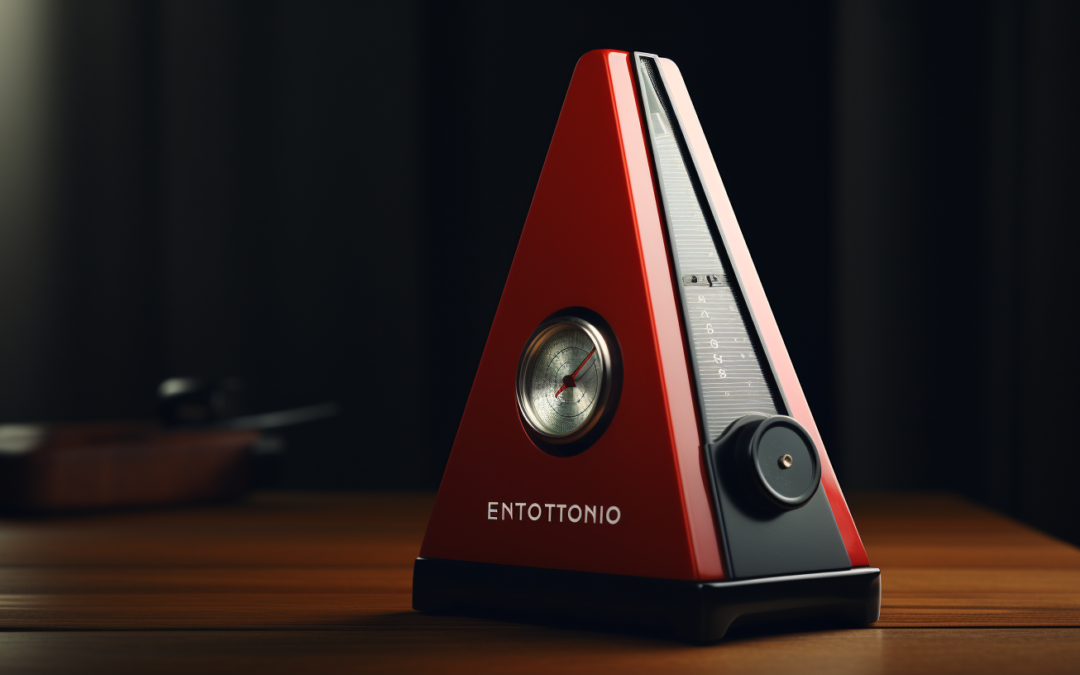Learning to play the piano can be a challenging but rewarding experience. One of the most important aspects of piano playing is timing. To play music accurately, pianists need to have a good sense of rhythm and be able to keep time. This is where a metronome can be a valuable tool.
A metronome is a device that produces a steady beat at a set tempo. It can be used to help musicians develop their timing and improve their ability to play at a consistent speed. By practicing with a metronome, pianists can increase their playing speed and accuracy, and develop a better sense of rhythm. In this article, we will explore how to use a metronome to increase piano playing speed.
Understanding the Metronome
A metronome is a tool that helps piano players keep a steady beat while playing. It produces a regular pulse or click at a set tempo, measured in beats per minute (BPM). The metronome has been used for centuries in music practice, and it is still an essential tool for many musicians today.
Traditionally, metronomes were mechanical devices that used a pendulum to produce the pulse. These traditional metronomes are still available today, but they have largely been replaced by electronic metronomes. Electronic metronomes use quartz technology to produce a more accurate and consistent pulse.
Digital metronomes are the most popular type of electronic metronome. They are small devices that can fit in a pocket or attach to a music stand. They can be programmed to produce a wide range of tempos, and they often have additional features like volume control and different sound options.
When using a metronome, it is important to choose the right tempo for the piece you are playing. A slow tempo is usually best for beginners, while more advanced players may prefer a faster tempo. It is also important to start with a tempo that is comfortable and gradually increase the speed as you become more proficient.
In addition to helping players keep a steady beat, the metronome can also be used to improve playing speed. By gradually increasing the tempo, players can build speed and accuracy over time. However, it is important not to rush the process. It takes time and practice to build speed, and players should always focus on playing accurately and with good technique.
Overall, the metronome is a valuable tool for piano players of all levels. It helps players develop a sense of rhythm and timing, and it can be used to build speed and accuracy over time. Whether using a traditional or electronic metronome, players should always focus on playing with good technique and gradually increasing the tempo as they become more proficient.
Importance of a Metronome in Piano Practice
A metronome is an essential tool for any pianist looking to improve their sense of rhythm, timing, and control. It is a device that produces a steady beat at a set tempo, allowing the pianist to practice playing at a consistent speed.
One of the most significant benefits of using a metronome during practice sessions is that it helps musicians develop accuracy and precision in their playing. When a pianist practices with a metronome, they are forced to play in time with the beat, which helps them develop a strong sense of rhythm. This, in turn, helps them play more accurately and with greater control.
Another advantage of using a metronome is that it helps pianists improve their timing and speed. By setting the metronome to a specific tempo, pianists can practice playing at a consistent speed and gradually increase the tempo as they become more comfortable. This allows them to develop their speed and timing gradually, without sacrificing accuracy.
Using a metronome also helps pianists develop a more efficient practice routine. By practicing with a metronome, they can focus on specific sections of a piece and work on them until they can play them accurately and consistently. This allows them to make the most of their practice time and achieve better results in less time.
Overall, a metronome is an invaluable tool for pianists looking to improve their playing. By helping them develop a strong sense of rhythm, timing, and control, it can help them become better musicians and achieve their goals more quickly and efficiently.
Choosing the Right Metronome
When it comes to choosing the right metronome, there are several options available. Traditional metronomes, electronic metronomes, and metronome apps for tablets and smartphones are all viable options. The right choice will depend on the player's needs and preferences.
Traditional metronomes are mechanical devices that produce a ticking sound. They are powered by a clockwork winding mechanism and do not require external power or batteries. These metronomes often have a swinging pendulum that helps the player keep time. They can be a good choice for those who prefer a tactile and visual cue for keeping time.
Electronic metronomes are battery-powered devices that produce a beeping sound. They often have a volume control and can be programmed to produce different sounds and tempos. These metronomes can be a good choice for those who prefer a consistent and precise sound.
Metronome apps are available for tablets and smartphones. They can be downloaded for free or purchased for a small fee. These apps often have a wide range of features, including volume control, different sounds and tempos, and the ability to save and share presets. They can be a good choice for those who want the convenience of a digital device and the ability to customize their metronome settings.
When choosing a metronome, it is important to consider the player's needs and preferences. Traditional metronomes can be a good choice for those who prefer a tactile and visual cue, while electronic metronomes and metronome apps can be a good choice for those who want a consistent and precise sound. It is also important to consider the volume control, as some metronomes can be quite loud and distracting.
Setting the Metronome
Setting the metronome is the first step to increasing piano playing speed. A metronome is a device that produces a regular pulse or beat, which is measured in beats per minute (BPM). Before setting the metronome, it is important to understand the time signature of the piece being played.
The time signature indicates the number of beats in each measure and the type of note that receives one beat. For example, in a 4/4 time signature, there are four beats in each measure, and a quarter note receives one beat. In a 3/4 time signature, there are three beats in each measure, and a quarter note receives one beat.
To set the metronome, first, determine the tempo of the piece. The tempo is the speed at which the music is played, and it is measured in BPM. The tempo can be found at the beginning of the piece, indicated by a word such as "Allegro" or "Adagio," or by a specific BPM marking.
Once the tempo is determined, set the metronome to the desired BPM. It is important to start with a slower tempo and gradually increase the speed as the player becomes more comfortable with the piece.
The volume of the metronome should be set at a level that is audible but not distracting. The pulse of the metronome should be felt but not overpowering.
Overall, setting the metronome is an important step in increasing piano playing speed. By starting with a slower tempo and gradually increasing the speed, the player can build muscle memory and accuracy, leading to faster and more precise playing.
Practicing with a Metronome
When it comes to increasing piano playing speed, practicing with a metronome is an essential tool. A metronome is a device that produces a steady beat that can help a pianist keep time while playing. Here are some tips for practicing with a metronome to increase piano playing speed:
Starting with Slow Practice
When using a metronome to increase piano playing speed, it's important to start with slow practice. This allows the pianist to focus on accuracy and timing, rather than speed. The metronome can help the pianist keep a steady tempo, which is essential for playing at faster speeds.
Increasing Speed Gradually
Once the pianist has mastered a piece of music at a slower tempo, it's time to start increasing the speed gradually. The metronome can be set to a slightly faster tempo, and the pianist can practice at this speed until they are comfortable. Then, the tempo can be increased again, and so on, until the desired speed is reached.
Maintaining Rhythm and Control
When practicing with a metronome, it's important to maintain rhythm and control. The metronome can help the pianist stay on beat, but it's up to the pianist to maintain control of their playing. This means playing each note accurately and with the correct timing.
Practicing Complex Rhythms
Practicing complex rhythms can be challenging, but using a metronome can help. The metronome can help the pianist keep time while practicing complex rhythms, which can make it easier to memorize the rhythm and play it accurately.
Using Metronome in Practice Sessions
Using a metronome in practice sessions can be helpful for pianists of all skill levels. It can help beginners develop a sense of timing and rhythm, and it can help advanced pianists increase their speed and accuracy. When practicing with a metronome, it's important to relax and focus on the music. The metronome should be used as a tool to help the pianist keep time, but it shouldn't become a distraction.
In conclusion, practicing with a metronome is an effective way to increase piano playing speed. By starting with slow practice, increasing speed gradually, maintaining rhythm and control, practicing complex rhythms, and using a metronome in practice sessions, pianists can improve their accuracy, timing, and overall playing ability.
Advanced Techniques
Subdivision and Counting
Once a pianist has become comfortable with playing along with a metronome, they can begin to experiment with more advanced techniques. One such technique is subdivision, which involves dividing the beats of the metronome into smaller parts. For example, if the metronome is set to 60 beats per minute, a pianist could practice playing sixteenth notes by playing four notes for every click of the metronome.
Counting is another technique that can help a pianist increase their speed and accuracy. By counting out loud while playing along with the metronome, a pianist can develop a stronger sense of rhythm and timing. For example, a pianist could count "1 and 2 and 3 and 4 and" while playing along with a metronome set to 120 beats per minute.
Playing with Different Volume Levels
Another technique that can help a pianist improve their playing speed is practicing playing with different volume levels. By practicing playing softly and loudly, a pianist can develop greater control over their touch and dynamics. This can help them play more expressively and with greater nuance.
Practicing Scales and Chords
Practicing scales and chords is another effective way to increase piano playing speed. By practicing these fundamental building blocks of music, a pianist can develop greater finger dexterity and hand coordination. They can also practice playing these scales and chords at different tempos, gradually increasing the speed over time.
By incorporating these advanced techniques into their practice routine, a pianist can continue to improve their piano technique and increase their playing speed. With regular practice and dedication, a pianist can achieve their goals and become a more skilled and confident player.
Using Metronome for Performance Preparation
When preparing for a performance, using a metronome can be an invaluable tool for musicians. It helps them to achieve greater control over their timing, rhythm, and speed, which are all crucial elements of a successful performance.
One of the most important ways a metronome can be used for performance preparation is by helping the musician to maintain a consistent tempo throughout a piece of music. This is especially important when playing with other musicians, as it ensures that everyone is playing at the same speed and in time with each other. It can also be useful when recording, as it ensures that the timing of the performance is consistent and accurate.
Another way a metronome can be used is by allowing the musician to practice at different speeds. By gradually increasing the tempo, they can build up their speed and control over a piece of music. This is particularly useful when working on difficult sections of a piece, as it allows the musician to focus on the timing and rhythm without being distracted by other technical aspects of the music.
Using a metronome can also help the musician to develop greater control over their timing and rhythm. By practicing with a metronome, they can learn to play with greater precision and accuracy, which can help to improve their overall piano playing.
Finally, a metronome can be useful for musicians who are working with a conductor or composer. By practicing with a metronome, they can become more familiar with the tempo variations that may be required in a piece of music, and can be better prepared to respond to the conductor's or composer's direction during a performance.
In summary, using a metronome for performance preparation is an effective way for musicians to improve their timing, rhythm, and speed, and to achieve greater control over their piano playing. It can be particularly useful when working with other musicians, recording, or preparing for a performance with a conductor or composer.
Additional Tools and Resources
In addition to using a metronome, there are a variety of other tools and resources that can help piano players increase their speed and improve their overall playing ability. Here are a few options to consider:
Metronome Apps
While traditional metronomes are still widely used, many piano players are turning to metronome apps that can be downloaded onto a smartphone or tablet. These apps often offer more features and flexibility than traditional metronomes, including the ability to customize rhythms and tempos, and to save and share practice sessions. Some popular metronome apps include Pro Metronome, Metronome Plus, and Tempo.
Tuners
In addition to keeping time, a good tuner can help ensure that a piano is in tune and sounding its best. There are a variety of tuner apps available, as well as standalone tuning devices that can be used with a keyboard or other instrument.
Sheet Music
Having access to a wide range of sheet music can help piano players develop their skills and explore different styles and genres. There are many websites and apps that offer free or low-cost sheet music, including IMSLP, Musopen, and Virtual Sheet Music.
Recording Devices
Recording practice sessions can be a valuable tool for piano players who want to track their progress and identify areas for improvement. A simple smartphone or tablet can be used to record audio or video, or a dedicated recording device can be used for higher-quality recordings.
Keyboard Devices
While traditional pianos are still the gold standard for many players, there are a variety of keyboard devices that can be used for practice and performance. These include digital pianos, MIDI controllers, and synthesizers, which offer a range of features and styles to suit different needs and preferences.
Overall, there are many tools and resources available to help piano players improve their skills and increase their playing speed. By experimenting with different options and finding what works best for them, players can take their playing to the next level and achieve their musical goals.
Conclusion
Using a metronome is a great way to increase piano playing speed. It helps pianists develop a sense of timing and rhythm, which is essential for playing faster pieces accurately. By practicing with a metronome, pianists can gradually increase their playing speed without sacrificing accuracy.
Some tips for using a metronome effectively include starting slow, focusing on accuracy, breaking down pieces into smaller sections, and gradually increasing the tempo. It's also important to practice regularly and consistently to see improvement over time.
While using a metronome can be challenging at first, with practice, it becomes an essential tool for pianists looking to improve their speed and accuracy. It's important to remember that everyone progresses at their own pace, and it's okay to start slow and work your way up gradually.
Overall, incorporating a metronome into piano practice can be a game-changer for pianists looking to improve their playing speed and accuracy. With patience, dedication, and consistent practice, pianists can achieve their goals and become more confident in their abilities.
Frequently Asked Questions
How do you use a metronome to increase speed?
Using a metronome to increase piano playing speed is a great way to improve your timing and rhythm. First, choose a piece of music you want to play and set the metronome to a slow tempo. Play the piece at this tempo, making sure to stay in time with the metronome. Once you feel comfortable playing the piece at this tempo, gradually increase the metronome speed. Continue doing this until you reach your desired tempo.
What is a good metronome speed for piano?
The ideal metronome speed for piano playing depends on the piece of music being played. Generally, slower pieces of music require slower tempos, while faster pieces require faster tempos. A good starting point for beginners is around 60 beats per minute (BPM), and then gradually increasing the tempo as they become more comfortable with the piece.
Is it good to practice piano with metronome?
Practicing piano with a metronome is highly recommended, as it helps to improve timing and rhythm. It also helps to develop a sense of consistency in playing, which is essential for playing with other musicians. Using a metronome can also help to identify areas of weakness in your playing, allowing you to focus on improving those areas.
How can I improve my piano tempo?
Improving piano tempo requires regular practice with a metronome. Start by playing a piece of music at a slow tempo and gradually increasing the speed as you become more comfortable with the piece. Focus on playing with a consistent rhythm and timing, and practice playing with both hands at the same time. It's also important to practice playing different types of music to develop a variety of skills.
Best metronome for piano beginners
For beginners, a digital metronome with a clear and easy-to-read display is recommended. The Korg TM-60 is a popular choice, as it has a large display and can also be used as a tuner. The Boss DB-90 is another great option, as it has a variety of features and can be used to create custom rhythms.
Metronome for piano app
There are many metronome apps available for smartphones and tablets that are specifically designed for piano players. Some popular options include the Pro Metronome app, which has a variety of features and can be customized to suit individual needs, and the Metronome Beats app, which has a simple and easy-to-use interface.
Harlan Kilstein began playing piano during covid with no piano background at all. He taught himself how to play learning what to do and what not to do.
Today he's an advanced intermediate player and can help you grow in your skills because he learned all this on his own.







